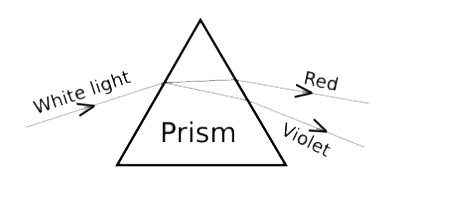Boojho made light from a laser torch to fall on a prism. Will he be able to observe a band of seven colours? Explain with a reason.
To determine whether Boojho can observe a band of seven colors when light from a laser torch falls on a prism, we need to consider the nature of the light emitted by the laser torch and how prisms work.
1. Understanding Laser Light:
- Laser light is monochromatic, meaning it consists of a single color or wavelength of light. For example, a red laser emits only red light.
2. Understanding Prisms:
- A prism works by refracting (bending) light. When white light (which contains multiple colors) passes through a prism, it is separated into its constituent colors, creating a spectrum. This spectrum typically shows seven colors: red, orange, yellow, green, blue, indigo, and violet.
3. Application to Boojho's Experiment:
- Since Boojho is using a laser torch, the light from the laser is not white light but a single color. When this single color of laser light passes through the prism, it will not be separated into multiple colors.
4. Conclusion:
- Therefore, Boojho will not be able to observe a band of seven colors. He will only see the single color of the laser light that is being directed through the prism.
Final Answer:
Boojho will not be able to observe a band of seven colors because the laser light is monochromatic and consists of only one color. Prisms separate white light into multiple colors, but since laser light is not white light, it does not produce a spectrum.
---
- Laser light is monochromatic, meaning it consists of a single color or wavelength of light. For example, a red laser emits only red light.
- A prism works by refracting (bending) light. When white light (which contains multiple colors) passes through a prism, it is separated into its constituent colors, creating a spectrum. This spectrum typically shows seven colors: red, orange, yellow, green, blue, indigo, and violet.
- Since Boojho is using a laser torch, the light from the laser is not white light but a single color. When this single color of laser light passes through the prism, it will not be separated into multiple colors.
- Therefore, Boojho will not be able to observe a band of seven colors. He will only see the single color of the laser light that is being directed through the prism.
Boojho will not be able to observe a band of seven colors because the laser light is monochromatic and consists of only one color. Prisms separate white light into multiple colors, but since laser light is not white light, it does not produce a spectrum.
Topper's Solved these Questions
- LIGHT BOOK - NCERT EXEMPLARCHAPTER - LIGHT EXERCISE - LONG ANSWER QUESTIONS
3 Videos
- LIGHT BOOK - NCERT EXEMPLARCHAPTER - LIGHT EXERCISE - VERY SHORT ANSWER QUESTIONS (True or False)
4 Videos
- HEATBOOK - NCERT EXEMPLARCHAPTER - HEATEXERCISE - SHORT ANSWER QUESTIONS
11 Videos
- MOTION AND TIMEBOOK - NCERT EXEMPLARCHAPTER - MOTION AND TIMEEXERCISE - LONG ANSWER QUESTIONS
3 Videos
Similar Questions
State the cause of dispersion of white light by a glass prism. How did Newton, using two identical glass prisms, show that white light is made of seven colours ? Draw a ray diagram to show the path of a narrow beam of white light through a combination of two identical prisins arranged together in inverted position with respect to each other, when it is allowed to fall obliquely on one of the faces of the first prism of the combination.
View SolutionWhen a beam of white light is passed through a prism, it splits to form lights of seven colours. Is it possible to recombine the lights of seven colours to obtain the white light again ? Explain your answer.
View Solution
Knowledge Check
In a Young's double slit set-up, light from a laser source falls on a pair of very narrow slits separated by 1.0 micrometer and bright fringes separated by 1.0 millimeter are observed on a distant screen. If the frequency of the laser light is doubled, what will be the separation of the bright fringes ?
A0.25 mmB0.5 mmC1.0 mmD2.0 mmWho discovered by his experiments with glass prisms that white light consists of seven colours?
ANewtonBFaradayCMaxwellDYoungAssertion (A): When white light passes through a tiangular prism, the emergent light consists of light of seven colours.
Reason (R):Name of seven colours can be remembered by the acronym VIBGYOR.ABoth (A) and (R) are true and (R) is correct explanation of the assertion.BBoth (A) and (R) are true but (R) is not the correct explaration of the assertion.C(4) is true but (R) is false.D(A) is false but (R) is true.

A student observes the above phenomenon in the lab as a white light passes through a prism. Among many other colours, he observed the position of the two colours Red and Violet. What is the phenomenon called? What is the reason for the violet light to bend more than the red light?
View SolutionBoojho made the circuit shown in Fig. 14.10. He wanted to observe what happens when an electric current is passed through water. But he forgot to add a few drops of lemon juice to water. Will it make any difference to his observations? Explain.

View SolutionThe prism spit the incident white light into a band of colours. Write these colours name in sequence .
View SolutionLight of wavelength 6000Å from a distance source falls on a slit 0.5 mm wide. The distance between two dark bands on each side of the central bright band of the diffraction pattern observed on a screen placed at a distance 2m from the slit is
View SolutionWhen white light is dispersed into seven colours by a prism, ………… light bends the least.
View Solution
